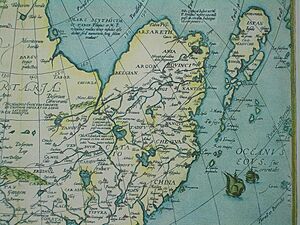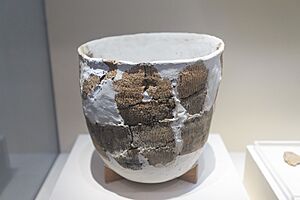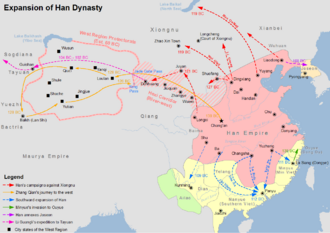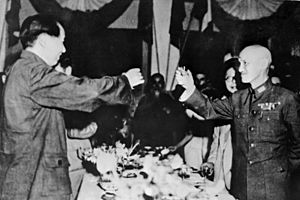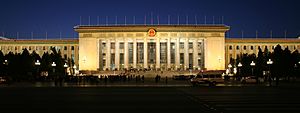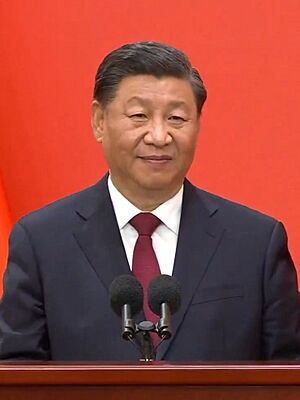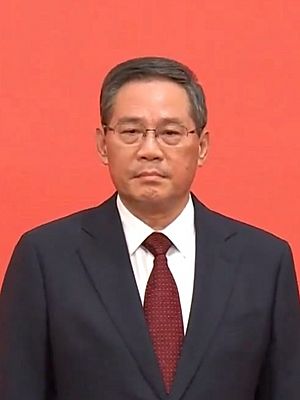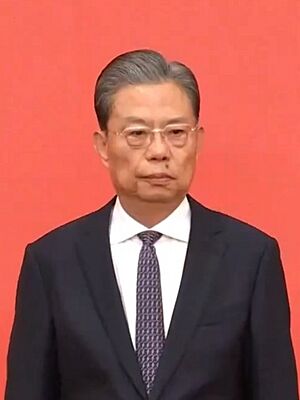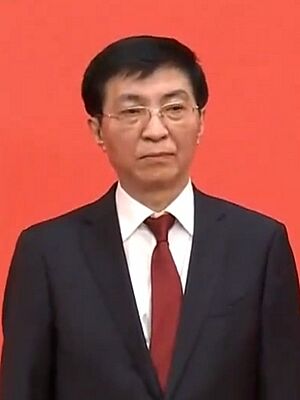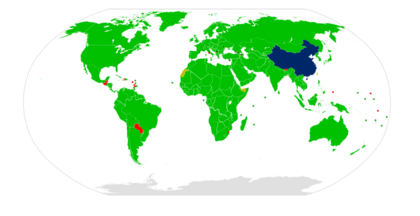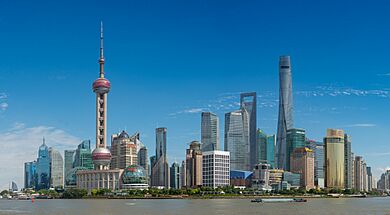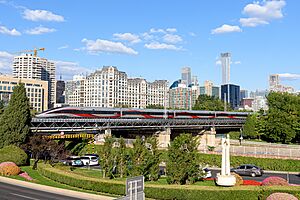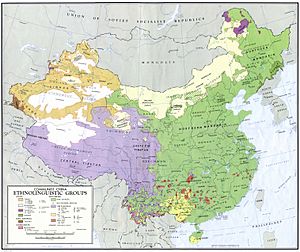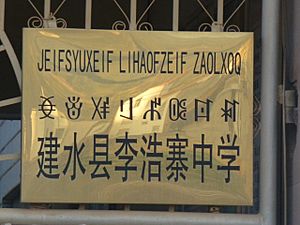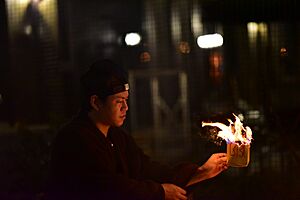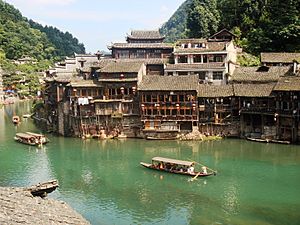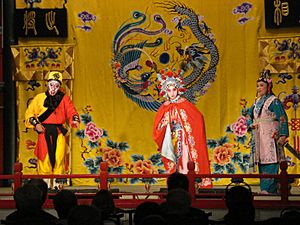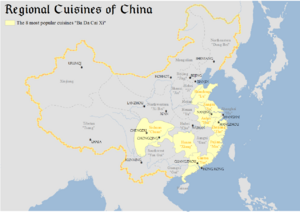China facts for kids
Quick facts for kids
People's Republic of China
|
|
|---|---|
|
|
|
|
Anthem: "March of the Volunteers"
|
|
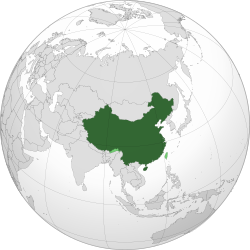
Location of the People's Republic of China Territory claimed but not controlled
|
|
| Capital | Beijing 39°55′N 116°23′E / 39.917°N 116.383°E |
| Largest city | Chongqing |
| Largest city | Shanghai |
| Official languages | Standard Chinese (de facto) |
|
Official script
|
Simplified Chinese (Chinese mainland), Traditional Chinese (Hong Kong, Macau) |
| Ethnic groups
(2020)
|
|
| Demonym(s) | Chinese |
| Government | Unitary Marxist–Leninist one-party socialist republic |
| Xi Jinping | |
|
• Premier
|
Li Qiang |
| Zhao Leji | |
| Legislature | National People's Congress |
| Formation | |
| c. 2070 BCE | |
| 221 BCE | |
| 1 January 1912 | |
|
• Proclamation of the People's Republic
|
1 October 1949 |
| Area | |
|
• Total
|
9,596,961 km2 (3,705,407 sq mi) (3rd/4th) |
|
• Water (%)
|
2.8 |
| Population | |
|
• 2024 estimate
|
|
|
• Density
|
147/km2 (380.7/sq mi) (83rd) |
| GDP (PPP) | 2025 estimate |
|
• Total
|
|
|
• Per capita
|
|
| GDP (nominal) | 2025 estimate |
|
• Total
|
|
|
• Per capita
|
|
| Gini (2021) | ▼ 35.7 medium |
| HDI (2023) | high · 78th |
| Currency | Renminbi (元/¥) (CNY) |
| Time zone | UTC+8 (CST) |
| Calling code |
|
| ISO 3166 code | CN |
| Internet TLD | |
China, also known as the People's Republic of China (PRC), is a huge country in East Asia. It has a population of over 1.4 billion people, making it the second-most populated country in the world, after India. China is also the third-largest country by land area, covering nearly 9.6 million square kilometers. It stretches across five time zones and shares borders with fourteen other countries.
China is divided into 33 main areas, including provinces, autonomous regions, and cities. Beijing is the capital city, and Shanghai is its largest city by population and a major financial hub. China is considered one of the world's first "cradles of civilization," where human history began millions of years ago.
Contents
What's in a Name?
The name "China" has been used in English since the 1500s. It likely came from an old Indian word, Cīna, which might have been inspired by the Qin dynasty (221–206 BCE).
The official name today is the "People's Republic of China." The shorter name, "China," comes from the Chinese words zhōng (meaning 'central') and guó (meaning 'state'). This name, Zhongguo, is also translated as 'Middle Kingdom'.
China's Long History
Ancient Beginnings
People have lived in China for over 2 million years. Early humans like Peking Man used fire hundreds of thousands of years ago. Some of the earliest forms of Chinese writing appeared around 6600 BCE.
Early Dynasties
The Xia dynasty is traditionally thought to be the first dynasty, starting around 2070 BCE. The Shang dynasty followed, ruling the Yellow River valley until about 1100 BCE. We have clear records and archaeological finds from the Shang period. The oracle bone script from this time is the oldest known Chinese writing.
The Zhou dynasty then took over, ruling for many centuries. During this time, different states began to fight each other in periods known as the Spring and Autumn period and the Warring States period.
Imperial China's Golden Ages
Unification and Empire
In 221 BCE, the Qin state unified China under one emperor, starting more than 2,000 years of imperial rule. The first emperor, Qin Shi Huang, standardized writing, measurements, and currency. He also began connecting walls to form parts of the Great Wall of China.
The Han dynasty (206 BCE–220 CE) followed, greatly expanding China's territory. This era helped shape the identity of the Han Chinese people today. The Silk Road, an important trade route, was established during the Han dynasty, connecting China to Central Asia and beyond.
Flourishing Dynasties
After some periods of division, the Sui dynasty reunited China in 581 CE. They built the Grand Canal, a huge waterway. The Tang dynasty and Song dynasty that followed were golden ages for China. Art, technology, and the economy thrived. The Tang capital, Chang'an, was a bustling global city. The Song dynasty was the first to use paper money and had a strong navy.
During the Song dynasty, China's population grew to about 100 million people, thanks to new ways of growing rice. Neo-Confucianism and beautiful art like landscape art and porcelain also flourished.

Mongol Rule and the Ming Dynasty
The Mongols, led by Kublai Khan, conquered China and established the Yuan dynasty in 1271. After about a century, a peasant leader named Zhu Yuanzhang overthrew the Yuan and founded the Ming dynasty in 1368.
The Ming dynasty saw another period of growth and cultural richness. China had a powerful navy, and Admiral Zheng He led famous voyages across the Indian Ocean, reaching as far as East Africa. The capital moved to Beijing during this time.
The Last Dynasty: Qing

The Qing dynasty ruled from 1644 to 1912. It was China's last imperial dynasty. During this time, China's population grew rapidly, and trade expanded. However, in the 1800s, China faced challenges from European powers and Japan, leading to conflicts like the Opium Wars. These wars forced China to open up to foreign trade and give up some control over its ports.
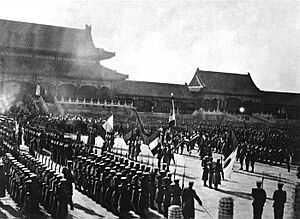
Internal rebellions also weakened the Qing dynasty. Finally, the 1911 Revolution ended the Qing dynasty and the long history of emperors in China.
Modern China: Republic and People's Republic
Establishing the Republic
On January 1, 1912, the Republic of China was formed. However, the country faced political instability and was divided by different warlords. In the late 1920s, the Kuomintang (KMT) party, led by Chiang Kai-shek, reunified much of the country.
A civil war began in 1927 between the KMT and the Chinese Communist Party (CCP). This conflict was paused when Japan invaded China in 1937, starting the Second Sino-Japanese War. Both sides fought against the Japanese. After Japan's surrender in 1945, the civil war continued.
Birth of the People's Republic
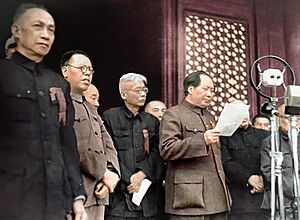
In 1949, the Communists, led by Mao Zedong, gained control of most of mainland China. On October 1, 1949, Mao Zedong officially announced the creation of the People's Republic of China in Beijing. The KMT government moved to the island of Taiwan.
In the early years of the PRC, there were big changes like land reforms. Some large-scale projects, like the Great Leap Forward, aimed to industrialize the country quickly but led to a severe famine. Later, the Cultural Revolution caused a lot of social and political unrest.
Reforms and Growth
After Mao's death in 1976, Deng Xiaoping became a key leader. He started major economic reforms in 1978, moving China towards a market-based economy. This led to incredible economic growth.
In 1989, there were protests for more democracy, especially in Tiananmen Square. These protests were ended by military action. China continued its economic reforms, and in 1997 and 1999, Hong Kong and Macau returned to Chinese control. China joined the World Trade Organization in 2001.

Under leaders like Hu Jintao and Xi Jinping, China has continued its rapid economic growth. It has become the world's second-largest economy. China also launched the Belt and Road Initiative in 2013, a huge project to build infrastructure and connect countries around the world.
China's Geography

China has a very diverse landscape. In the north, you'll find dry deserts like the Gobi Desert. In the south, there are lush subtropical forests. Major mountain ranges like the Himalayas separate China from its southern neighbors.
The Yangtze River and Yellow River are two of the world's longest rivers. They flow from the Tibetan Plateau to the eastern coast, where many people live. China's coastline along the Pacific Ocean is very long, with different seas like the Yellow Sea and South China Sea.
The world's highest point, Mount Everest, is on China's border with Nepal. The lowest point is Ayding Lake, which is below sea level.
Climate and Environment
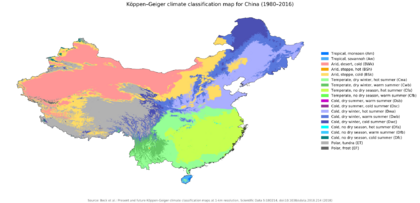
China's climate is mostly affected by dry seasons and wet monsoons. This means there are big temperature differences between winter and summer.
One big environmental challenge is the expansion of deserts, especially the Gobi. China has planted many trees to help stop sandstorms. Water pollution and air pollution are also major concerns. China is working to reduce pollution and has invested a lot in renewable energy. It's the world leader in making and using renewable energy technologies.
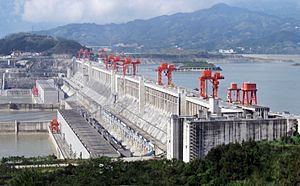
China is the world's largest producer of many crops, including rice and wheat. It has a climate that is very good for farming.
Amazing Animals and Plants
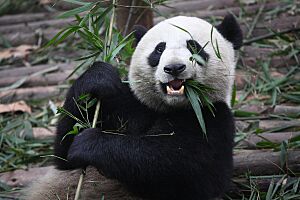
China is one of the most biodiverse countries in the world, meaning it has a huge variety of animals and plants. It's home to many mammals, birds, reptiles, and amphibians.
Some famous animals include the giant panda, which is an endangered species found only in China. Many animal species are threatened due to human activities like habitat loss. China has created many nature reserves to protect its wildlife.
China also has over 32,000 types of plants. You can find cold coniferous forests in the north and subtropical forests in the south. Tropical rainforests in areas like Yunnan are home to a quarter of all China's animal and plant species.
How China is Governed
China is a one-party state led by the Chinese Communist Party (CCP). The CCP says it is guided by "socialism with Chinese characteristics." The country's constitution states that China is a "socialist state" led by the working class.
The CCP controls the government. Most top government officials are members of the CCP. The National People's Congress (NPC) is the highest state body, with nearly 3,000 members. It meets once a year.
The current leader of the CCP and President of China is Xi Jinping. He is also the commander-in-chief of the armed forces. The Premier, Li Qiang, is the head of government.
Foreign Relations
China has diplomatic relations with most countries in the world. In 1971, China took its seat as a permanent member of the United Nations Security Council. It is also a member of many important international groups like the G20 and BRICS.
China has a "one China principle," meaning it believes there is only one China, and Taiwan is part of it. This can sometimes lead to disagreements with other countries. China's foreign policy often focuses on peaceful cooperation and trade. It has strong ties with countries in Africa, Europe, and South America.
China's Military Power
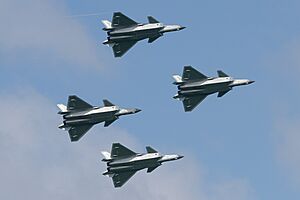
The People's Liberation Army (PLA) is China's military. It is considered one of the most powerful in the world and has been rapidly modernizing. It has the largest number of active military personnel globally, with nearly 2.2 million people.
The PLA also has the world's third-largest number of nuclear weapons and the second-largest navy. China's military budget is the second-largest in the world.
Human Rights and Society
China's constitution guarantees rights like freedom of speech and religion. However, some international groups have raised concerns about how these rights are practiced. The government has strict controls over information and the internet.
There have been reports of challenges for ethnic minorities in some regions, like Xinjiang. The government has also increased its control in Hong Kong.
Despite these concerns, many surveys show that people in China are generally satisfied with their government. This is often linked to improvements in living standards and security.
China's Economy

China has the world's second-largest economy by total value and the largest when you consider what people can buy with their money (purchasing power). Its economy has grown incredibly fast since 1978.
China is the world's largest manufacturer and exporter. It makes a huge variety of goods, from textiles to cars and electronics. It's also the world leader in electric vehicle production and sales.
Tourism in China
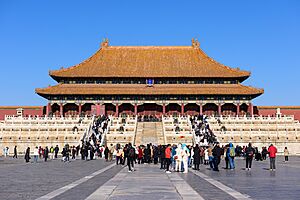
China is a very popular place for tourists. In 2019, it was the fourth-most visited country in the world. It also has a huge amount of domestic tourism, with billions of trips made within the country each year.
China has the second-largest number of World Heritage Sites, with 60 sites recognized by UNESCO. Famous attractions include the Forbidden City in Beijing and parts of the Great Wall.
Wealth and Poverty
China holds a significant portion of the world's total wealth. It has lifted more people out of extreme poverty than any other country in history. Between 1978 and 2018, over 800 million people moved out of extreme poverty.
The average standard of living has increased dramatically. However, there is still a big difference in wealth between cities and rural areas. China has a large middle class, which grew to 500 million people by 2024. It also has the second-highest number of billionaires and millionaires in the world.
China in the Global Economy
China joined the World Trade Organization in 2001 and is now the world's largest trading power. It is the biggest trading partner for many countries around the globe.
China has the largest foreign exchange reserves in the world. It also invests a lot of money in other countries. The Chinese currency, the renminbi, is becoming more important in global trade.
Science and Technology
Historical Innovations
For a long time, China was a world leader in science and technology. Many important inventions came from ancient and medieval China, including papermaking, printing, the compass, and gunpowder. These "Four Great Inventions" changed the world. Chinese mathematicians were also the first to use negative numbers.
Modern Advancements
Today, China is investing heavily in scientific research and development. It spends a large portion of its GDP on R&D. China leads the world in patents and has some of the fastest supercomputers.
China is also focusing on science, technology, engineering, and mathematics (STEM) in its education system. It publishes the most scientific papers in the world.
Space Exploration
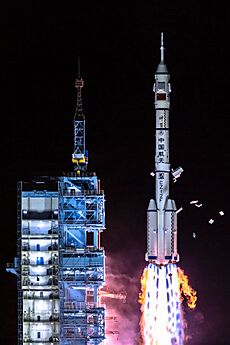
China's space program began in 1958. In 1970, it launched its first satellite, becoming the fifth country to do so independently. In 2003, China became the third country to send humans into space on its own.
China has achieved many impressive feats in space. In 2019, it was the first country to land a probe on the far side of the Moon. In 2021, it landed a spacecraft and a rover on Mars. China completed its own space station, Tiangong, in 2022. In May 2024, China successfully brought back samples from the far side of the Moon, a world first!
Infrastructure and Transport
China has built many impressive infrastructure projects. It has the largest high-speed rail network, the most supertall skyscrapers, and the largest power plant, the Three Gorges Dam.
Telecommunications
China has the largest telecom market in the world. It has over 1.7 billion active cellphones and more than 1.1 billion internet users. China is also a leader in 5G technology.
Chinese companies like Huawei and ZTE are major players in global telecommunications. China has also developed its own satellite navigation system called BeiDou.
Getting Around China

China has greatly expanded its road network, now having the longest highway system in the world. It's also the world's largest market for cars. Bicycles are still a very common way to get around in cities.
China's railways are among the busiest globally. It has the longest high-speed rail network in the world, with trains reaching very high speeds. The Shanghai maglev train is the fastest commercial train service. Many Chinese cities also have large metro systems.
Air travel has grown rapidly, and China has many airports. Its ports are also among the busiest in the world, handling a huge amount of global trade.
People and Culture
Population and Cities
China's population was about 1.41 billion in 2020. The country has seen a lot of urbanization, with more people moving to cities. Over 67% of the population now lives in urban areas.
China has more than 160 cities with over a million people. Some of its largest cities, like Chongqing, Shanghai, and Beijing, have populations over 20 million.
Diverse Ethnic Groups
China officially recognizes 56 different ethnic groups. The largest group is the Han Chinese, who make up over 91% of the population. Other ethnic minorities live in various parts of the country.
Languages Spoken
There are many languages spoken in China, but most belong to the Sinitic family, like Mandarin Chinese. Mandarin is the national language and helps people from different language backgrounds communicate. Other languages like Tibetan, Uyghur, and Mongolian are spoken by ethnic minority groups.
Religion and Beliefs
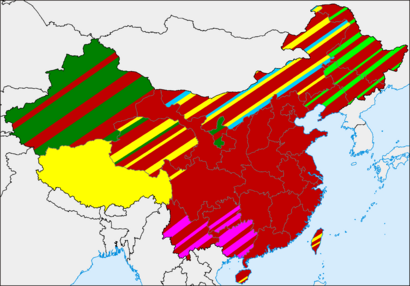
■ Chinese folk religion (including Confucianism, Taoism, and groups of Chinese Buddhism)
■ Buddhism tout court
■ Islam
■ Ethnic minorities' indigenous religions
■ Mongolian folk religion
■ Northeast China folk religion influenced by Tungus and Manchu shamanism; widespread Shanrendao
China's constitution guarantees freedom of religion. Historically, Chinese culture has been shaped by "three doctrines": Confucianism, Taoism, and Buddhism. These beliefs are often mixed with Chinese folk religion, which involves worshiping nature deities and ancestors.
Many Chinese people practice traditional folk beliefs, even if they don't formally belong to a religion. There are also specific religions for ethnic groups, like Tibetan Buddhism and Islam.
Education System
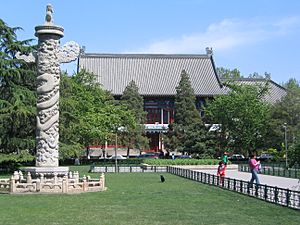
Education in China is compulsory for nine years, covering primary and junior secondary school. To go to university, students take a national exam called the Gaokao.
China has the largest education system in the world, with millions of students and teachers. Its literacy rate has greatly improved over the years. China also has a huge number of universities, with many ranking among the top in the world.
Health and Well-being
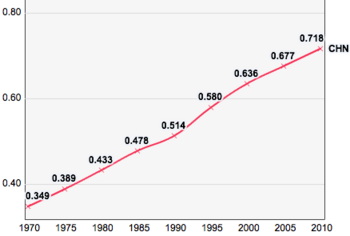
China has made big improvements in public health. Diseases that were once common have been nearly wiped out. Healthcare has also improved, and most of the population has basic health insurance.
Life expectancy in China is now over 78 years. However, challenges remain, such as respiratory illnesses from air pollution and an increase in obesity among young people.
Chinese Culture and Arts
 Chinese culture has a very long history and has been deeply influenced by Confucianism. It has also had a big impact on other countries in East and Southeast Asia. Traditional arts like calligraphy, poetry, and painting are highly valued.
Chinese culture has a very long history and has been deeply influenced by Confucianism. It has also had a big impact on other countries in East and Southeast Asia. Traditional arts like calligraphy, poetry, and painting are highly valued.
Today, traditional Chinese culture is seeing a strong revival. Many forms of art, literature, music, and architecture are popular again.
Architecture Styles

Chinese architecture has developed over thousands of years. It often features symmetry, enclosed spaces, and a focus on horizontal lines. Buildings are designed with symbolic elements. Famous examples include pagodas and palaces. Different regions of China also have their own unique architectural styles.
Literature and Stories
Chinese literature dates back to ancient times. Important classical texts cover history, philosophy, and more. Classical Chinese poetry flourished during the Tang dynasty, with famous poets like Li Bai.
Chinese fiction became very popular during the Ming dynasty. Some of the most famous novels include Journey to the West and Dream of the Red Chamber. These stories are still loved today and inspire many popular cultural works.
Music and Fashion
Chinese music is very diverse, from traditional sounds to modern pop. Traditional instruments are often grouped into eight categories. Chinese opera is a form of musical theater with different regional styles.
Hanfu is the traditional clothing of the Han people. The qipao is a well-known Chinese dress for women. There's a growing movement to bring back traditional Hanfu clothing.
Delicious Chinese Food
Chinese cuisine is incredibly diverse and has thousands of years of history. There are "Eight Major Cuisines," each with its own unique flavors and cooking methods.
Rice is a staple food in the south, while wheat-based breads and noodles are common in the north. Pork is the most popular meat. You can also find vegetarian Buddhist cuisine and pork-free Chinese Islamic cuisine. Chinese food is enjoyed all over the world!
Sports and Games
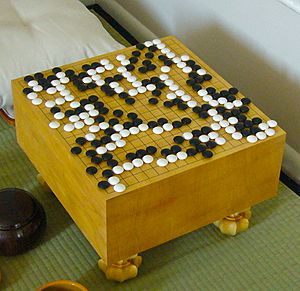
China has a very old sporting culture. Ancient sports include archery and a game similar to football called cuju.
Today, basketball is very popular in China. Other favorite sports include martial arts, table tennis, badminton, and swimming. Many traditional sports like dragon boat racing are also enjoyed.
China has hosted several major international sports events, including the 2008 Summer Olympics in Beijing and the 2022 Winter Olympics, making Beijing the first city to host both Summer and Winter Games.
See also
 In Spanish: República Popular China para niños
In Spanish: República Popular China para niños
- Outline of China




